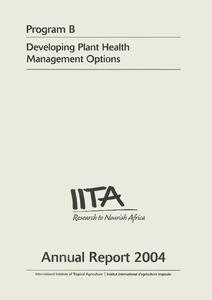| dc.contributor.author | Ogbe, F. |
| dc.contributor.author | Atiri, G. |
| dc.contributor.author | Thottappilly, G. |
| dc.contributor.author | Dixon, A. |
| dc.date.accessioned | 2019-12-04T11:24:12Z |
| dc.date.available | 2019-12-04T11:24:12Z |
| dc.date.issued | 2003 |
| dc.identifier.citation | Ogbe, F.O., Atiri, G.I., Dixon, A.G.O. & Thottappilly, G. (2003). Cassava mosaic disease and its causal agents: the Nigerian situation. In Proceedings of a conference on Plant Virology in Sub Saharan Africa, 4-8 June 2001, Ibadan, Nigeria, (pp. 411-422). |
| dc.identifier.isbn | 978 131 214 9 |
| dc.identifier.uri | https://hdl.handle.net/20.500.12478/4309 |
| dc.description.abstract | Highlights are presented on the status of knowledge about cassava mosaic disease (CMD) and its causal agents in Nigeria. The disease occurs in all the agroecologies where cassava is grown, from the humid forest in the south to the semiarid and arid agroecologies in the north. The severity is generally moderate but can be very severe on susceptible genotypes. A severe outbreak of the disease was recorded in the late 1980s in Akwa Ibom State in southeastern Nigeria and was curtailed through the use of resistant genotypes. The causal agent had been African cassava mosaic virus but East African cassava mosaic virus (EACMV) was identifi ed in 1997 as an additional causal agent. EACMV was limited in distribution to the humid forest, derived/coastal, and southern Guinea savannas. The two viruses occur mainly in mixed infections. Bemisia tabaci, the whitefly vector of the viruses, is host-specifi c; those infesting cassava are different from those infesting other crops such as cowpea, tomato, and sweetpotato. The decrease in the rate of spread of CMD from the humid forest to the semiarid and arid regions reflects the gradients of whitefly population and cassava cultivation. Storage root yield loss ranges between 32 and 69%. Adoption of cultural control methods is limited. Some of the resistant cassava landraces are usually interplanted with the improved resistant genotypes to control the disease. Proposed areas of further work are suggested for effective control of the disease. |
| dc.language.iso | en |
| dc.subject | Cassava |
| dc.subject | Plant Diseases |
| dc.subject | African Cassava Mosaic Virus |
| dc.title | Cassava mosaic disease and its causal agents: the Nigeria situation |
| dc.type | Conference Paper |
| dc.type | Conference Paper |
| dc.description.version | Peer Review |
| cg.contributor.crp | Roots, Tubers and Bananas |
| cg.contributor.affiliation | National Root Crops Research Institute, Nigeria |
| cg.contributor.affiliation | University of Ibadan |
| cg.contributor.affiliation | International Institute of Tropical Agriculture |
| cg.contributor.affiliation | Mahyco Research Foundation, India |
| cg.coverage.region | Africa |
| cg.coverage.region | West Africa |
| cg.coverage.country | Nigeria |
| cg.authorship.types | CGIAR and developing country institute |
| cg.iitasubject | Cassava |
| cg.accessibilitystatus | Limited Access |
| local.dspaceid | 99875 |

